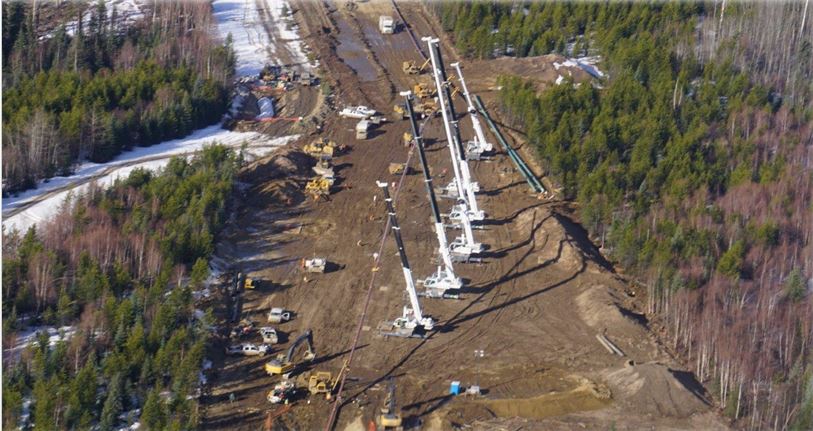The Great Valley Intersect
August 18, 2016 by Joseph
Filed under Prime Blog
Drayton Valley 1,000 m Intersect, Alberta, Canada.
During the early winter months of 2015 Precise Crossings of Spruce Grove, Alberta contracted Prime Horizontal to assist in the completion of a 1,000 meter crossing of the Brazeau River in Drayton Valley. Due to the tough ground conditions and a narrowing schedule, an intersect was decided as the best solution for completion.
Drayton Valley is located on Highway 22, or what’s locally known as the Cowboy Trail, some 80 miles southwest of Edmonton, Alberta. The historic Cowboy Trail features horseback trail rides, farm and ranch vacations, guest ranches, western themed attractions, accommodations, adventures, historic sites and western themed shopping. The valley is surrounded by Brazeau County, known for its vast oil fields located between the Pembina River and the North Saskatchewan River, just to paint a picture of the jobsite environment.
The main contractor for the project was Tourmaline Oil Corp, a Canadian intermediate crude oil, natural gas exploration, and Production Company. Precise Crossings filled the roll of trenchless contractor, utilizing their 40+ years of experience in the Horizontal Directional Drilling industry.
The project’s consulting engineer, planning, and supervision was undertaken by CCI Inc., a leading expert in Horizontal Directional Drilling (HDD), Open-Cut and Micro-Tunneling methods since 2004.
Prime Horizontal was selected for the project due to extensive knowledge of wireline guidance and horizontal intersects along with demonstrated ability to surmount the obstacles that were expected when carrying out a drilled crossing of the Brazeau River.
One obstacle was ground conditions, which included variations of gravel and sand on both entry and exit side. This formation contributes to difficult fluid control, troublesome steering and poor hole sustainability.
The project managers, based on their local knowledge of the potential difficulties and prior to commencing work, both for the planning stage and practical contracting purposes, carried out ground investigation works to best identify the formations to be drilled for planning purposes. Geotechnical holes were drilled on both entry and exit sides showing the depths of the gravel seams. To help alleviate the ground condition issues on the entry side, 25 meters of casing was required, and on the exit side 45 meters of casing was used.
The difference in length was due to the exit side elevation being substantially higher. The casing would prevent the flow of returns and constant working of the drill string from disturbing layers of sand and gravel resulting in potential hole collapse and increased annular pressures. It also does not allow the assembly to deviate from the already drilled hole when tripping in and out.
In addition to casing, Precise Crossings proposed doing the installation with two smaller rigs and performing an intersect in order to manage fluid pressures more effectively. Smaller rigs using smaller mud motors require less mud volume and pressure to drill than their larger counterparts, resulting in their choice for this project. A drilled intersect allows two smaller rigs to span the length of the same crossing in an acceptable time frame. Maintaining drilling fluid returns for the overall distance of the entire bore is made simpler since only half of the total distance is required from each side. Overall fluid velocity remains higher, annular pressure stays lower thus formation cuttings stay suspended in each hole.
The rigs that were utilized on both entry and exit side were American Augers DD-110 rigs. Precise Crossings had a custom made mud system with Derrick Hyperpool Shakers and Gardner Denver mud pumps on each end of the intersect. The Down Hole Assembly was a 7 7/8” Tricone TCI bit on a 4 ¾” mud motor. The pipe pulled was an 8” steel product line.
The ParaTrack-2 AC Guidance system with the Rotating Magnet Ranging System was chosen and used to intersect the two drills. Rotating Magnet guidance was used because the project timeframe was rushed and needed to have the best chance of intersecting on the first attempt as road bans were imminent and moving heavy equipment would not be possible if intersect operations took too long. The ParaTrack-2 Rotating Magnet Ranging System offers ranging accuracy that is unparalleled by other passive magnetic downhole ranging products.
Results from the RMRS system can be well modeled with up to 40 meters of separation, where Passive Magnetic systems struggle beyond 4 meters. At close range the RMRS resolution is more enhanced, supplying operators with better data to make more accurate steering decisions.
The rig on exit side was mobilized first and drilled 480m of the pilot hole, and then reamed up to 14 inches in diameter. While reaming was taking place on the exit side, the entry side rig started drilling their pilot hole towards the exit side. Upon completion of the exit side reaming, the rotating magnet was tripped into the exit side to begin the intersect procedure.
The entry side drilled up to the end of the exit sides bore at about the halfway point of the crossing. On March 8th the first ranging pass-by was completed showing a lateral separation of only one meter and another meter vertically. The gap was closed over the course of 60 meters in a 12 hour shift and intersection was accomplished at around noon on March 9th. Once the intersect was performed, both rigs tripped out of the hole and the entry side began forward reaming to 14 inches in preparation to pull pipe.
Precise Crossings mobilized on February 6th, consequently completing the pilot on March 9th, hence the pipe was pulled on March 14th, thus making this project a success. Prime Horizontal was mobilized for guidance of the exit side on the 28th of February; intersect operations commenced on the 8th of March and successfully concluded on the 9th of March, 2015.
– Article written by C. Joseph, J. Teer and S. Teer, Prime Horizontal Group of Companies







